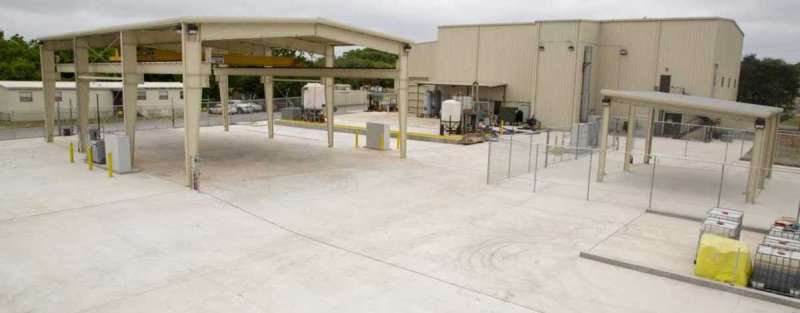The Flow Component Testing Facilities (FCTF) consist of a number of dedicated facilities housed in a single location that are used to perform both standard and custom testing. SwRI engineers will be exhibiting the Institute’s CO2 SSSV testing capabilities, as well as the other FCTF valve testing capabilities, at the Valve World Americas Expo & Conference in Houston, Texas Oct. 13-14 at Booth no. 405. Credit: Southwest Research Institute
The Southwest Research Institute (SwRI) Nitrogen Blowdown Facility has succeeded at recreating the intense conditions of a gas event, making it possible to test subsurface safety valves' (SSSV) ability to withstand associated gas flow rates at high pressures to prevent injury, loss of life and environmental effects.
Part of SwRI's Flow Component Testing Facilities (FCTF), the Nitrogen Blowdown Facility recorded its highest-ever nitrogen flow rate: 310 million standard cubic feet per day (MMscfd) at 2,400 pounds per square inch gauge (psig). With this new standard set, SwRI now offers more strenuous testing for subsurface safety valves and other safety and pollution prevention equipment, especially as the energy industry looks toward cleaner energy.
SwRI is expanding its valve testing capabilities to include evaluating existing SSSVs for carbon capture and storage (CCS) applications. In recent years, oil and gas companies have begun a transition toward cleaner energy alternatives.
One such shift is aimed at capturing and sequestering carbon dioxide (CO2) to reduce greenhouse emissions. Locations currently being considered for CO2 storage are generally subsurface, such as caverns, reservoirs or depleted oil wells. SSSVs will be used for safeguarding these storage applications.
"The Institute has provided third-party SSSV validation testing since 1975," said Christopher Jowers, principal engineer with SwRI's Fluids Engineering Department. "Since that time, we have continually expanded our third-party testing role in the development of new SSSVs and more to ensure that we meet industry needs. The demand for CCS applications is worldwide, and it is something SwRI can help with."
According to Jowers, SwRI has seen a rise in testing demand for equipment that can handle CCS applications. Many oil and gas companies want to ensure that existing valves and safety measures will work for CO2 storage and withstand the related challenges.
"CO2 storage is a challenging application for subsurface safety valves to withstand because the fluid can be very cold and can also become a solid under certain conditions," said Nicole Lemon, research engineer with SwRI's Fluids Engineering Department. "Test parameters are much different than typical oil and gas production applications, because the properties of CO2 change more dramatically based on temperature and increased pressure, which could lead to a dangerous gas release event. Due to this, increased safety measures are required for any testing program with CO2."
Investigating how existing SSSV designs perform at cold temperatures in CCS applications is critical prior to long-term service. SwRI has experience with cryogenic and extreme cold testing, and the Institute is prepared to help the energy industry evaluate existing SSSV designs and test newly developed hardware.
"There are a lot of considerations that must go into testing," Lemon said. "With SwRI's new capabilities, we can test existing SSSVs up to current standards as well as test new innovations in the technology."
SwRI's facilities are accredited through the American Petroleum Institute (API) to perform validation testing on both surface and subsurface safety valves. The facilities also accommodate safety testing on other downhole safety, riser isolation and wellhead valves. All testing is completed under API Q1 and ISO 17025 quality management systems.
SwRI engineers will be exhibiting the Institute's CO2 SSSV testing capabilities, as well as the other FCTF valve testing capabilities, at the Valve World Americas Expo & Conference in Houston, Texas Oct. 13–14 at booth no. 405.
Provided by Southwest Research Institute
























